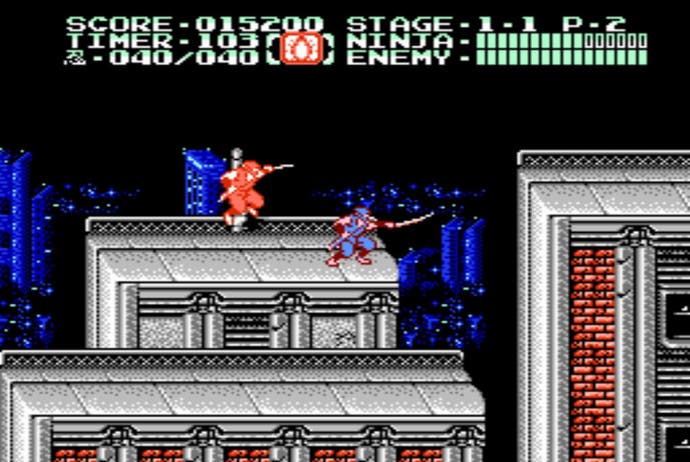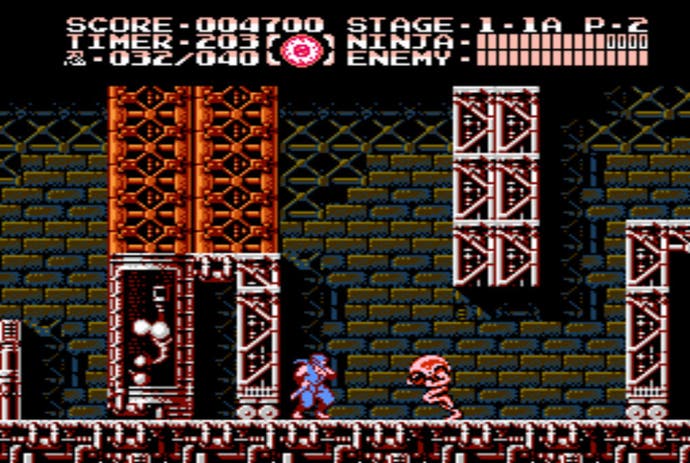History of Ninja Gaiden
Twenty years of pain and pyjamas.
Ninja Gaiden is the franchise that never was, a famous videogame brand that has clocked up over ten titles without ever adhering to any consistent continuity. These are games that play almost identically, yet often have little in common beyond the name of the lead character and a propensity for fiendish difficulty levels. But still they endure, most recently revived and resuscitated by the mercurial talents of Tomonobu Itagaki and Team Ninja. Today gamers fidget in anticipation to see what the outspoken development wizard has come up with. Two decades ago, however, Ninja Gaiden was just getting started, launching in the arcades and on the NES in a peculiar criss-cross release pattern.
Vengeful ninja Ryu Hayabusa arrived in American arcades in 1988, the same year he launched on the NES in Japan in Ninja Ryukenden, or Legend of the Ninja Dragon Sword. By 1989 the two nations had swapped over, with the arcade machine reaching Japan and the NES game hitting the US. For those of us in the rest of the world (or the PAL territories at least) the same game arrived under the name Shadow Warriors, the title under which Ocean pumped out numerous home versions for the ZX Spectrum, Commodore 64 and others.
Already, the nascent series was a bit of a muddle. Apart from having three different titles and zig-zagging release dates, the arcade machine bore little resemblance to the NES game bearing the same name. The former was a straight-forward beat-'em-up, firmly in the style of Double Dragon and Renegade. Ryu had access to a limited array of hand-to-hand attacks, and trotted from left to right mashing down a constant stream of enemies in hockey masks and colourful costumes. Despite his sprite clearly showing a sword strapped to his back, the iconic weapon of the series could only be used by picking up a time-limited power-up.

Arcade Ryu was reasonably athletic - able to swing from poles and somersault off objects - but combat was somewhat stiff and awkward compared to its genre peers of the time. It's not much of a surprise, then, that unlike most '80s arcade games, Ninja Gaiden never produced any sequel cabinets. Still, the game boasted several memorable elements - such as the outrageous 'continue' screen which, apropos of nothing, found Ryu pinned down by demons as a circular saw blade descended towards him.
It was the concurrent NES version that instead set the standard for the series, cribbing more from Shinobi with a faster pace, enemies that could be felled with one sweep of Ryu's sword (which now came as standard) and a greater emphasis on navigating the numerous platforms that made up the levels. The game also introduced the Windmill Shuriken, which could be used to kill enemies at a distance, and the special magical Ninja Arts attacks. One thing it had in common with the arcade version was being infamously and ferociously hard, with unforgiving boss fights and a cute habit of sending you back to the start of a stage should you fail.
The first NES Ninja Gaiden also introduced a number of sporadic story elements which would be teased out in future instalments. Characters such as Irene Lew and Foster, from the CIA Secret Auxiliary Unit, fleshed out the reasons behind Ryu's relentless battling with a conspiracy storyline revolving around Ryu's missing father, two magical demon statues and supervillain Jaquio. Ninja Gaiden II: Dark Sword of Chaos arrived in both the US and Japan in 1990, and continued Ryu's adventures against the forces of evil. Irene Lew returned as his love interest, now kidnapped by the villainous Ashtar. More familiar elements were added to the game for this second outing, including the ability to climb up walls and the Spirit Clones, indestructible echoes of Ryu which copied his every move.

Ninja Gaiden III: The Ancient Ship of Doom, the final instalment in the NES trilogy, launched in 1991 but as is typical with these things, Europe had been consistently short-changed in the release schedules. We finally got the first game just as America and Japan were tucking into Part 3, and we wouldn't see the second game until 1994. Unsurprisingly, this third game never even made it to Europe. The games had never been easy, but Ninja Gaiden III really turned the thumbscrews that little bit harder, especially in the US version which was made even tougher than the Japanese edition. Whereas previous games had at least offered infinite continues, players were now restricted to five, while enemies were made more powerful and the password system from the Japanese game was removed completely.
The story, never really a strong point of the series, had also pretty much gone completely off the rails by this point. Foster, the rogue CIA guy from the first game, returned along with another dodgy spy guy, Clancy. There was some guff about a trans-dimensional warship, genetically engineered BIO-NOIDS and four enormous "great beasts". It was a glorious load of old bollocks, and it was predictably this outlandish excuse for a story that was loosely pillaged for the short-lived Ninja Gaiden anime series, which debuted in the same year.








